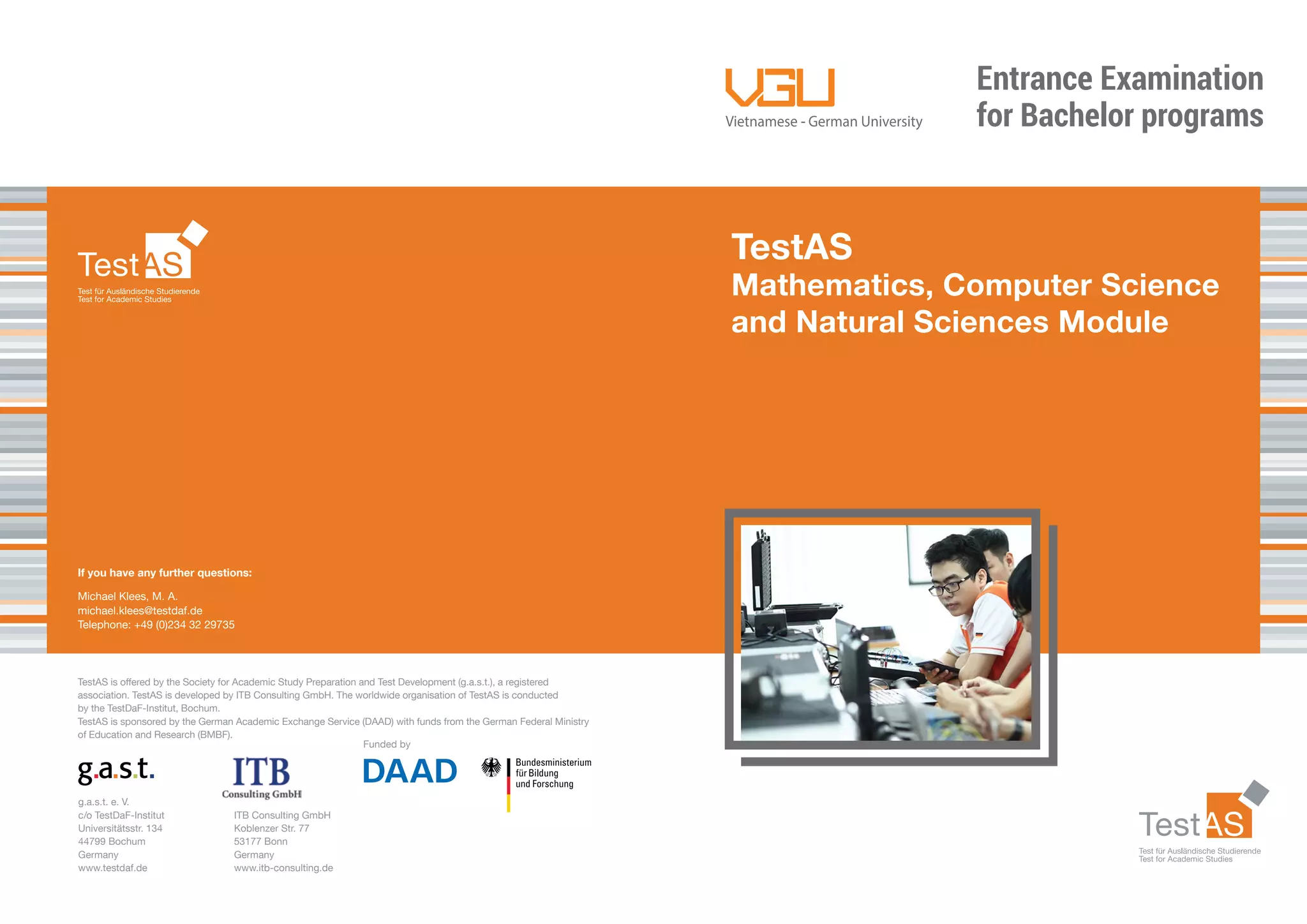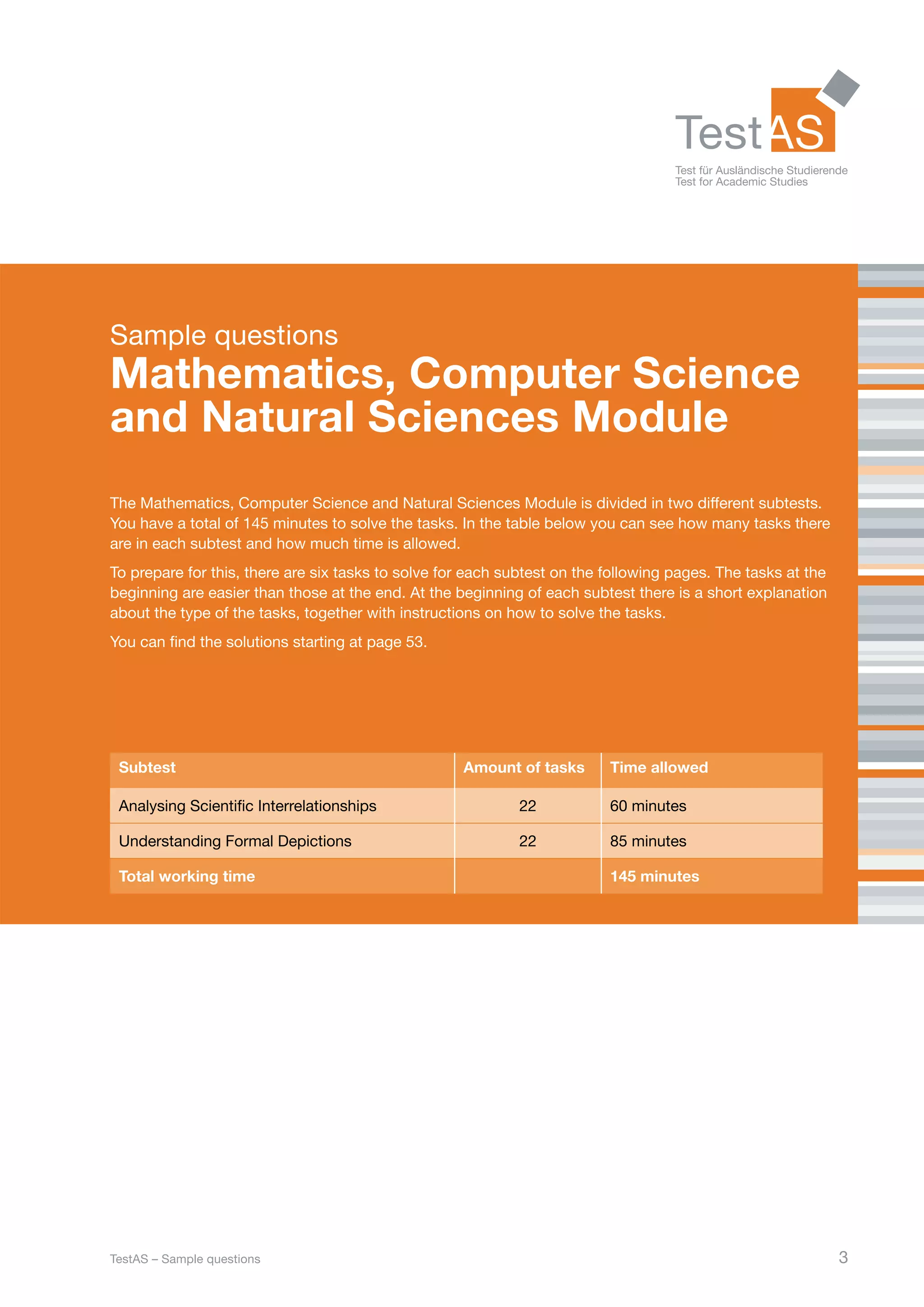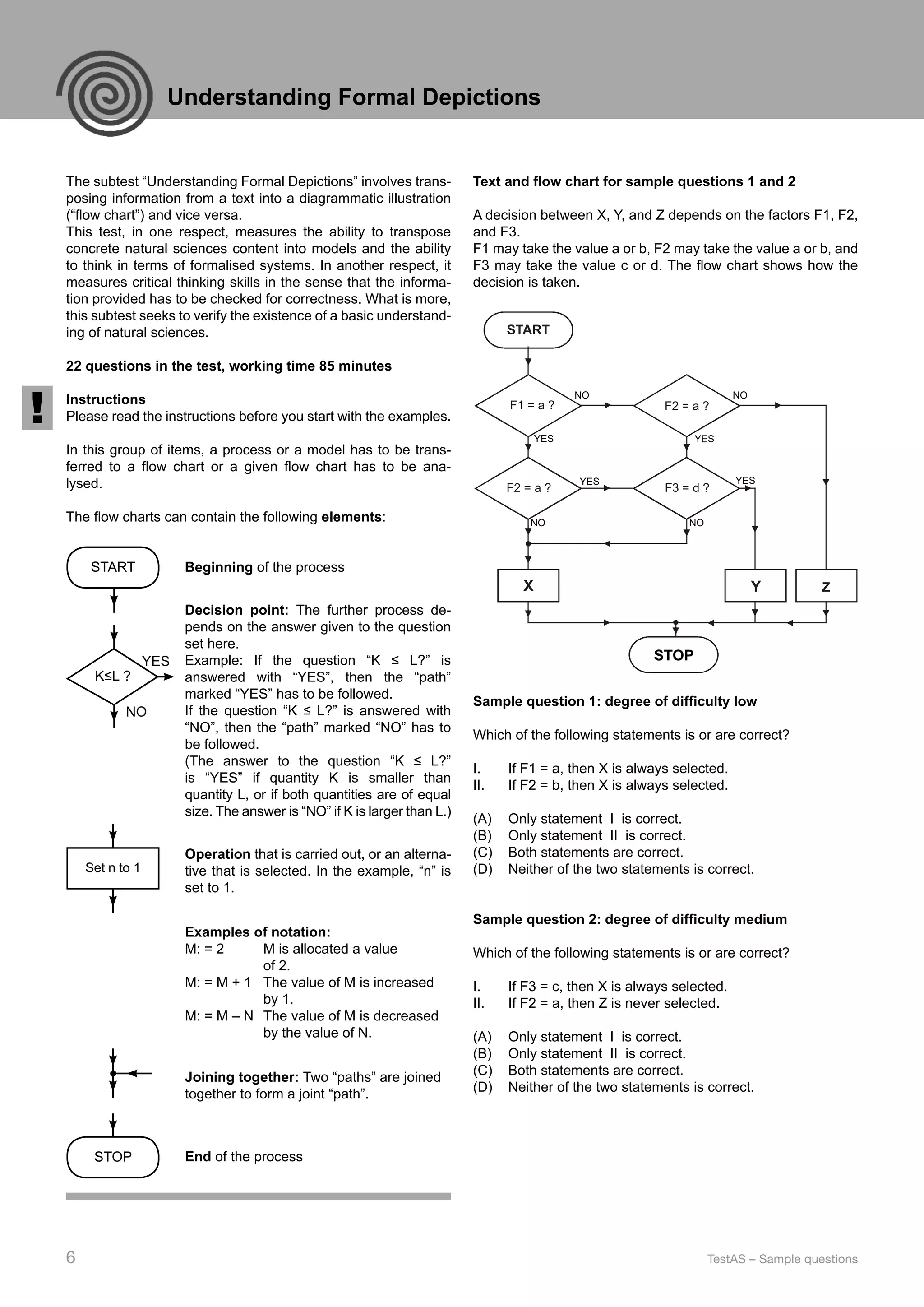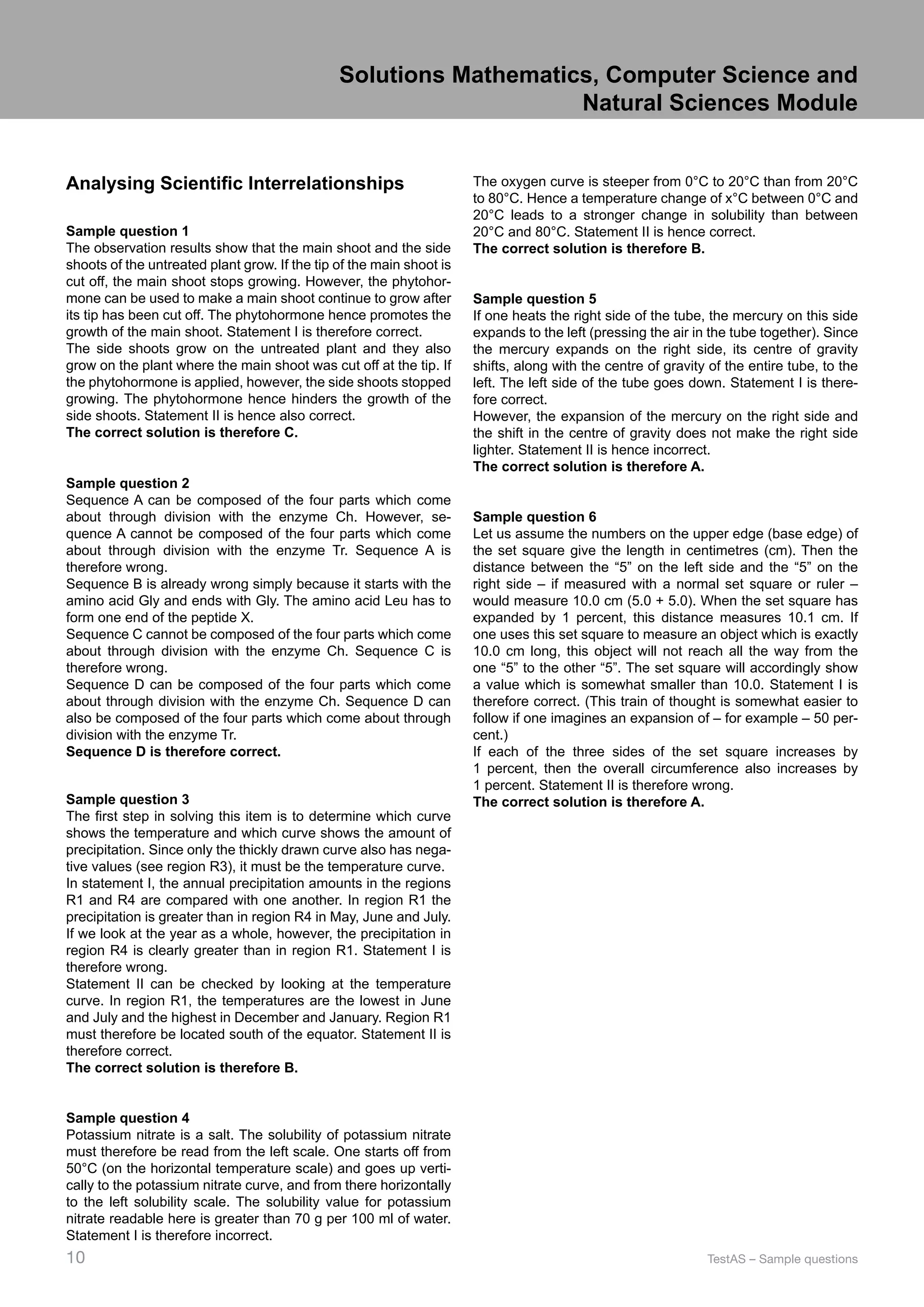This document provides sample questions for the TestAS entrance examination for bachelor's degree programs in mathematics, computer science, and natural sciences. The sample questions are divided into two subtests: Mathematics, Computer Science and Natural Sciences Module with 22 questions testing understanding of natural science topics, and Understanding Formal Depictions with 22 questions requiring the transposition of information into diagrams. Instructions and examples are provided for each subtest to help examinees prepare for the types of tasks involved.


![4 TestAS – Sample questions
texts and illustrations with natural sciences content on which
questions are then posed.
This test measures how well people can grasp and analyse
simple natural sciences topics. It is also a matter of recognising
interrelationships, separating important data from unimportant
data and drawing the right conclusions from the presented in-
formation. Relevant background information is provided.
22 questions in the test, working time 60 minutes
Instructions
Please read the instructions before you start with the examples.
are linearly subdivided.
In several items, you are asked to identify the “qualitatively”
correct diagram. In these cases, decide which diagram shows
the curve that best expresses the circumstances described.
Even the correct diagram may not be drawn in numerically
precise manner.
An experiment is conducted on three plants of the same spe-
cies:
• Plant 1 is not treated.
• The tip of the main shoot of plant 2 is cut off.
• The tip of the main shoot of plant 3 is cut off. Afterwards a
phytohormone is applied to the cut surface on the plant.
The plants are now placed under observa-
tion:
• The main shoot and the side shoots on
plant 1 grow.
• The main shoot on plant 2 does not
grow. The side shoots grow.
• The main shoot on plant 3 grows. The
side shoots do not grow.
These results are generally applicable to this
species of plant.
Which of the following statements is or are correct?
I. The phytohormone promotes the growth of the main
shoot of this plant species.
II. The phytohormone hinders the growth of the side shoots
of this plant species.
(A) Only statement I is correct.
(B) Only statement II is correct.
(C) Both statements are correct.
(D) Neither of the two statements is correct.
The peptide X consists of a chain of 10 amino acids. Each
amino acid is designated by three letters (for example: “Trp”).
The sequence of the amino acids is shown from left to right.
One end of the peptide is formed by the amino acid Gly, the
other end by the amino acid Leu.
With the enzyme Ch, the peptide X is split behind the amino ac-
ids Tyr and Trp. The following four parts come about as a result:
Lys – Gly
Leu – Ala – Tyr
Lys – Gly – Trp
Arg – Tyr
With the enzyme Tr, the peptide X is split behind the amino
acids Arg and Lys. The following four parts come about as a
result:
Gly – Trp – Arg
Tyr – Lys
Gly
Leu – Ala – Tyr – Lys
What is the structure of peptide X?
(A) Leu – Ala – Tyr – Arg – Tyr – Lys – Gly – Trp – Lys – Gly
(B) Gly – Trp – Arg – Leu – Ala – Tyr – Lys – Tyr – Lys – Gly
(C) Leu – Ala – Tyr – Lys – Arg – Tyr – Lys – Gly – Trp – Gly
(D) Leu – Ala – Tyr – Lys – Gly – Trp – Arg – Tyr – Lys – Gly
The climate of a certain region is described in terms of the av-
erage monthly temperatures (in °C) and the average monthly
amount of precipitation (rain in mm).
The illustrations below show climate charts of four different re-
gions (R1 to R4).
main
shoot
side
shoot
0
50
100
J
J F M A
Niederschlag
[mm]
0
50
100
0
25
50
-25
J
J F M A M J J A S O N D
Monat
Niederschlag
[mm]
Temperatur
[°C]
R3
0
50
100
J
J F M A
Niederschlag
[mm]
0
50
100
0
25
50
-25
J
J F M A M J J A S O N D
Monat
Niederschlag
[mm]
Temperatur
[°C]
R1
Month
Temperature
[°C]
Precipitation
[mm]
0
50
100
0
25
50
-25
J
J F M A M J J A S O N D
Monat
Niederschlag
[mm]
Temperatur
[°C]
R2
100 50
R3
100 50
R4
0
50
100
0
25
50
-25
J
J F M A M J J A S O N D
Monat
Niederschlag
[mm]
Temperatur
[°C]
R1
Month
Temperature
[°C]
Precipitation
[mm]
!](https://image.slidesharecdn.com/mathematics-computerscience-naturalsciences-230129160516-b757d5c6/75/Mathematics-Computer-Science-Natural-Sciences-pdf-3-2048.jpg)
![5
TestAS – Sample questions
Which of the two statements is or are correct?
I. The annual precipitation is greater in region R1 than
in region R4.
II. At least one of the four regions is located south of the
equator.
(A) Only statement I is correct.
(B) Only statement II is correct.
(C) Both statements are correct.
(D) Neither of the two statements is correct.
The diagram shows how the solubility of substances in water
is dependent on temperature. Potassium nitrate and sodium
chloride are salts (shown as grams of salt per 100 millilitres of
water). Oxygen and air are gases (shown as millilitres of gas
per 1 litre of water).
(A) Only statement I is correct.
(B) Only statement II is correct.
(C) Both statements are correct.
(D) Neither of the two statements is correct.
A closed tube is hung up so that it is in a balanced state. Both
The mercury on the right side of the tube is now heated.
Which of the two statements on the impact of this heating ac-
tion is or are correct? (Please note: the weight of the air in the
tube is to be ignored.)
I. The left side will go down.
II. The right side will become lighter.
(A) Only statement I is correct.
(B) Only statement II is correct.
(C) Both statements are correct.
(D) Neither of the two statements is correct.
A set square comprises a ruler and an angle gauge (a scale
for measuring angles). This particular set square consists of a
material which has expanded homogeneously by 1 percent in
all lengths since it (the set square) was manufactured.
Which of the two statements is or are correct?
I. When measuring length, the values shown by the
ruler are too small.
II. The circumference of the set square has increased
by 3 percent.
(A) Only statement I is correct.
(B) Only statement II is correct.
(C) Both statements are correct.
(D) Neither of the two statements is correct.
90
Which of the following two statements is or are correct?
I. 60 g of potassium nitrate does not fully dissolve in
100 ml of water at 50°C.
II. Within a temperature range of 0°C to 20°C,
the solubility of oxygen is more dependent on
temperature than in the temperature range
from 20°C to 80°C.
0
50
100
0
25
50
-25
J
J F M A M J J A S O N D
Monat
Niederschlag
[mm]
Temperatur
[°C]
R2
0
25
50
-25
O N D
Temperatur
[°C]
0
50
100
0
25
50
-25
J
J F M A M J J A S O N D
Monat
Niederschlag
[mm]
Temperatur
[°C]
R4
0
25
50
-25
O N D
Temperatur
[°C]
Month
Temperature
[°C]
Precipitation
[mm]
g Salz
pro
100 ml Wasser
ml Gas
pro
1 l Wasser
Löslichkeit
Löslichkeit
Temperatur
K
a
l
i
u
m
n
i
t
r
a
t
Sauerstoff
Luft
Kochsalz
110
90
70
50
30
10
0
0 10 20 30 40 50 60 70
60
50
40
30
20
0
10
°C
Temperature
Solubility
Solubility
g salt
per
100 ml water
ml gas
per
1 l water
Sodium Chloride
P
o
t
a
s
s
i
u
m
N
i
t
r
a
t
e
Air
O
xygen
0
50
0
25
-25
J
J F M A M J J A S O N D
Monat
Niederschlag
[mm]
Temperatur
[°C]
0
50
100
0
25
50
-25
J
J F M A M J J A S O N D
Monat
Niederschlag
[mm]
Temperatur
[°C]
R3
0
50
100
0
25
50
-25
J
J F M A M J J A S O N D
Monat
Niederschlag
[mm]
Temperatur
[°C]
R4
0
50
0
25
-25
J
J F M A M J J A S O N D
Monat
Niederschlag
[mm]
Temperatur
[°C]
Temperature
[°C]
Precipitation
[mm]
Month
Rohr
Quecksilber
Tube
Mercury](https://image.slidesharecdn.com/mathematics-computerscience-naturalsciences-230129160516-b757d5c6/75/Mathematics-Computer-Science-Natural-Sciences-pdf-4-2048.jpg)







